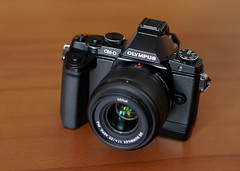Olympus OM-D

|
| Olympus OM-D E-M1 with m.Zuiko 8mm 1:1.8 Fisheye pro image by CWhatPhotos |
The Olympus OM-D system camera bodies resemble the 35mm Olympus OM SLR series. Again the concept is to surpass the concept of the average concurrent system cameras. Both of the first OM-Ds, the Olympus OM-D E-M5 (2012) and the newer E-M1 reached that goal. Despite of their smaller µ4/3 image sensors both cameras delivered excellent respectable image quality in comparison with average APS-C sensor format cameras. Finally, in 2014 a budget version, the E-M10 was released. Backed by this success, Olympus gave up its Four Thirds DSLR series since the mirrorless OM-D took over the lead in Olympus camera portfolio. The old Four-Thirds system lenses can be used via adapter on OM-Ds.

|
| Olympus OM-D E-M5 with Leica Summilux 1:1.4/25 image by fotograf@flickr (Image rights) |

|
| Olympus OM-D E-M10 body image by CWhatPhotos |
Contents
Mark II

|
| Olympus OM-D E-M1 Mark II image by Zoran Rodic (Image rights) |

|
| Olympus OM-D E-M5 with 12-50mm macro lens image by Paul Bailey (Image rights) |

|
| Olympus OM-D E-M10 Mark II with adapted Four Thirds lens image by Russell McNeil (Image rights) |

|
| Olympus OM-D E-M10 Mark II image by CiboloJIM (Image rights) |
In 2015 Olympus re-issued the OM-D E-M5, mightily reworked as Olympus OM-D E-M5 Mark II. Its new specialty is a 5-axis sensor-shift anti-shake mechanism. This is also used for an 8-shot High-Res imaging mode with 2.5× sensor resolution as image resolution. It also got a bigger, more detailed viewfinder image. An OM-D E-M10 Mark II was also launched. In 2016, the Mark II variant of the of the E-M1 was released as first 20 megapixel OM-D, with a better sensor giving overall improved image quality.

|
| Olympus OM-D E-M5 Mark II image by Stonepicker (Image rights) |
Mark III

|
| Olympus OM-D E-M10 Mark III with kit lens image by Niels Enderlein (Image rights) |

|
| from left to right: Olympus OM-D E-M5 Mark III, Mark I & Mark II image by CWhatPhotos (Image rights) |
The Mark III variant of the OM-D E-M10 was introduced by Olympus in 2017, the OM-D E-M10 Mark III S by OM in 2021, the E-M5 Mark III, which was the first 20 megapixel E-M5, by Olympus in 2019, the E-M1 Mark III in 2020.
Mark IV
The Mark IV variant of the OM-D E-M10 was introduced in 2020 by Olympus, finally having an E-M10 capable to shoot 20 megapixels, too.
flagship
The heavy-weight OM-D E-M1X is optimized for any professional usage. It was introduced in 2019.
OM System
The OM System OM-5 camera body is like the Olympus OM-D E-M5 Mark III, but with small changes and a few improvements, the latter comprising a Starry Sky astronomy mode autofocus, a 1920×1024 pixel webcam mode, an anti-flickering video mode, and art-filter bracketing.
The OM System OM-1 camera body is a more mightily reworked Olympus OM-D E-M1 Mark III, with a mightily improved autofocus with enhanced animal detection modes, greatly enhanced pixel resolutions of EVF and monitor, and a more powerful battery, thus making the model being another choice for professionals beside the OM-D E-M1X.